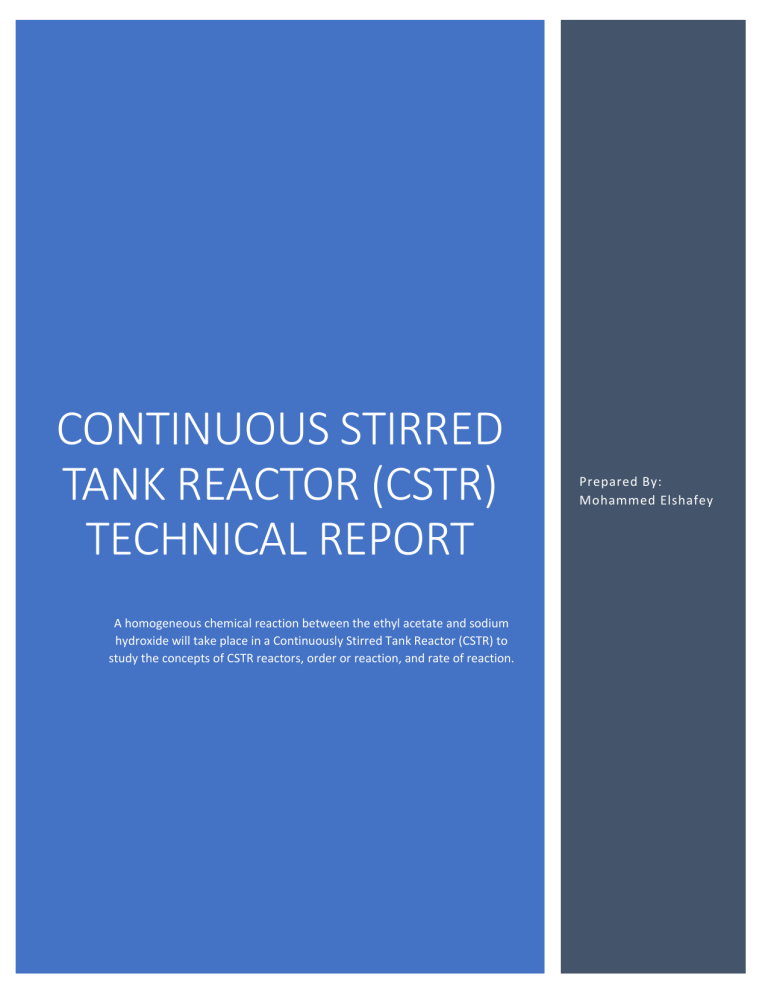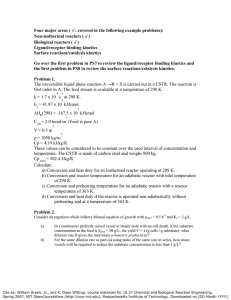
CONTINUOUS STIRRED
TANK REACTOR (CSTR)
TECHNICAL REPORT
A homogeneous chemical reaction between the ethyl acetate and sodium
hydroxide will take place in a Continuously Stirred Tank Reactor (CSTR) to
study the concepts of CSTR reactors, order or reaction, and rate of reaction.
Prepared By:
Mohammed Elshafey
Abstract
A homogeneous chemical reaction between the ethyl acetate and sodium hydroxide will take
place in a Continuously Stirred Tank Reactor (CSTR) to study the concepts of CSTR reactors,
order or reaction, and rate of reaction.
Table of Contents
Abstract ........................................................................................................................................................ 1
Introduction .................................................................................................................................................. 3
Continuously Stirred Tank Reactor (CSTR) ................................................................................................ 3
Procedures .................................................................................................................................................... 5
Experimental Results.................................................................................................................................... 6
First Trial ................................................................................................................................................... 7
Second Trial ............................................................................................................................................... 7
Third Trial .................................................................................................................................................. 8
Conclusion .................................................................................................................................................... 9
References .................................................................................................................................................. 10
Introduction
Continuously Stirred Tank Reactor (CSTR)
Continuously Stirred Tank Reactor (CSTR) is a type of reactors used in industrial processes based
on chemical reactions to provide efficient mixing of raw materials, CSTR mainly operates at
steady-state conditions to exhaust outputs with uniform properties and compositions
independent of position and time in the reactor vessel, hence the operating variables of the
reactor must be associated with the properties of the final outputs. (Sam Catalano, n.d.)
(University of Michigan, n.d.) (Wikipedia, 2019) (Wikipedia, 2019)
Agitation rate and residence time distribution are important factors in CSTR reactor operation,
where agitation rate determines the needed power by the impellers or the agitators of the
reactor to force the fluid to flow in specified flow regimes or patterns (Ex. circle). The agitation
rate will affect the residence time distribution which is the time spent by the inlet stream
molecules at the stagnant or unmixed areas of the reactor vessel which may affect the required
properties and compositions of the final output if the design of the reactor is not suitable for
the needed operation. (Kubilius, 2015) (Vamsi, 2008) (Wikipedia, 2019)
One of the CSTR problems is molecules infinite residence time, where the molecules in the
reactor vessel will have a different residence time according to its position in the reactor, these
variances in addition to the uniform concentration of the molecules will lead to slow conversion
rate. One of the solutions to solve this problem and avoid increasing construction, and pumping
cost is to build several smaller reactors connected in a sequential way to operate as a plug flow
reactor with different concentrations from point to point along the flow path where the
reaction rate will higher than the model of one large CSTR with high construction, pumping, and
maintenance cost. (University of Michigan, n.d.) (Anne-Marie BILLET, 2019)
Advantages of CSTR Reactors: (University of Michigan, n.d.)
Good temperature control.
Low operating cost.
Easy cleaning.
Simple construction models.
Disadvantages of CSTR Reactors: (University of Michigan, n.d.)
Low conversion rate per unit volume.
By-passing and channeling possible with poor agitation.
Procedures
1. Load the 10 L of Ethyl acetate solution (0.1M) in tank 1 and the 10 L (0.1M) of NaOH
solution in the tank.
2. Switch the interface and run the QRCAC program.
3. Mark in the program the temperature at which you want to work for (for example,
30℃).
4. Put the three-way valves of the base module at recirculation position.
5. Mark the initial low flow in both pumps and connect them from the program.
6. The flow meters should mark the same flow, although in a different percentage.
7. After about 20 minutes, when the flow has reached the stationary state, put the threeway valves of the module in circulation to the reactor.
8. When the conductivity cell indicated a constant value (the process has been stabilized)
make the following steps:
a. Take a 5 ml product sample at the reactor outlet.
b. Quench this sample with 10 ml of 0.1N HCL.
c. Titrate this mixture with 0.1N NaOH until the endpoint is reached and note the
used volume.
d. Calculate the unreacted HCL from which you can determine the amount of HCL
used to neutralize the unreacted NaOH in the product sample.
9. Stop the pumps and mark a different value of flow. Repeat the measurement for
different values of 𝐹𝑁𝑎𝑂𝐻 and 𝐹𝐸𝑇𝑂𝐴𝐶 . For a good analysis of the results, attempt to carry
out more than 4 experiments.
Experimental Results
Numb
er of
Sampl
e
Time
(Min
.)
Normali
ty
Volume
of
𝑵𝒂𝑶𝒉
(Used
for
Titratin
g)
Volume
of
Unreact
ed 𝑯𝑪𝒍
Normalit
y×
Volume
of
Unreact
ed 𝑯𝑪𝒍
React
or
Volum
e
Conc.
𝑳𝒏 (𝑪𝒐𝒏𝒄. )
𝟏
𝑪𝒐𝒏𝒄.
Initia
l
Conc.
Average
Flow Rate
Conversi
on
1
0
0.1
2.9
7.1
0.71
5
0.14
-
7.0422535
0.14
18.193333
0
2
1,9519282
21
2
33
6.9444444
0.14
18.193333
Residence
Time
𝝉
𝑽𝒐𝒍𝒖𝒎𝒆
=
𝑭𝒍𝒐𝒘 𝑹𝒂𝒕𝒆
0.39025284
21
2
3
0.1
2.8
7.2
0.72
5
0.14
4
1.9379419
44
2
33
6.9444444
0.14
18.193333
−2
× 10
0.39574935
−3
9
79
3
5
0.1
2.8
7.2
0.72
5
0.14
4
1.9379419
44
2
33
6.6666666
0.14
18.193333
−2
× 10
0.39574935
−3
9
79
4
9
0.1
2.5
7.5
0.75
5
0.15
1.8971199
67
2
33
7.1428571
0.14
18.193333
−8
× 10
0.41223991
−3
5
85
5
12
0.1
3
7
0.7
5
0.14
1.9661128
43
2
33
7.2463768
0.14
18.193333
2
× 10
0.38475632
−3
1
56
6
18
0.1
3.1
6.9
0.69
5
0.13
8
1.9805015
4
× 10
0.37925980
−3
2
12
2
33
-
7.1428571
0.14
18.193333
1.9661128
43
2
33
× 10−3
1
0.016
0.34628068
94
7
20
0.1
3
7
0.7
5
0.14
2
0.38475632
56
8
30
0.1
3.7
6.3
0.63
5
0.12
-
7.9365079
0.14
18.193333
6
2.0714733
37
2
33
10
0.14
18.193333
2
33
9
72
9
34
0.1
5
5
0.5
5
0.1
2.3025850
0.042
0.27482594
4
93
10
37
0.1
5.5
4.5
0.45
5
0.09
-
11.111111
0.14
18.193333
2.4079456
11
2
33
09
0.052
0.24734334
9
First Trial
Plot a curve between concentration versus time, if it gives a uniform straight line with K = slope, it will be zero order.
Since the graph does not give a straight line as it is expected, so it is not zero order.
Second Trial
plot a curve between ln(concentration) versus time, if it gives a straight line with K = - slope,
it will be first order.
Since the graph does not give a straight line as it is expected, so it is not first order.
Third Trial
Plot a curve between 1/concentration versus time, if it gives straight line with K= slope,
it will be second order.
Since it gives straight line with positive slope, so it is a second order reaction.
Conclusion
The order of homogeneous reaction between sodium hydroxide and ethyl acetate took place in
a CSTR reactor had determined. The reaction started by mixing the sodium hydroxide with ethyl
acetate, then a sample of the product mixture had taken every 2 Minutes, followed by adding
HCl to quench the reaction, and using phenolphthalein as indicator, then it was titrated with
sodium hydroxide to determine the amount of unreacted HCl, after three trials it was
discovered that reaction is in the second order.
References
Anne-Marie BILLET, O. L. (2019, January 29). 5 minutes to understand plug flow reactors. Retrieved from
YouTube: https://www.youtube.com/watch?v=3flM6rAUk10
Kubilius, L. (2015, October 14). What is Residence Time Distribution in Chemical Reaction Engineering?
Retrieved from Quora: https://www.quora.com/What-is-Residence-Time-Distribution-inChemical-Reaction-Engineering
Sam Catalano, S. W. (n.d.). Continuous Stirred Tank Reactors. Retrieved from Visual Encyclopedia of
Chemical Engineering:
http://encyclopedia.che.engin.umich.edu/Pages/Reactors/CSTR/CSTR.html
University of Michigan. (n.d.). Continuous Stirred Tank Reactors (CSTRs). Retrieved from University of
Michigan: http://umich.edu/~elements/asyLearn/bits/cstr/index.htm
Vamsi. (2008, October 9). For Chemical engineers(Mixing and Agitation theory). Retrieved from Just for
you : http://vamsi81.blogspot.com/2008/10/for-chemical-engineersmixing-and.html?m=1
Wikipedia. (2019, November 19). Chemical reactor. Retrieved from Wikipedia:
https://en.wikipedia.org/wiki/Chemical_reactor#CSTR_(continuous_stirred-tank_reactor)
Wikipedia. (2019, November 24). Continuous stirred-tank reactor. Retrieved from Wikipedia :
https://en.wikipedia.org/wiki/Continuous_stirred-tank_reactor



